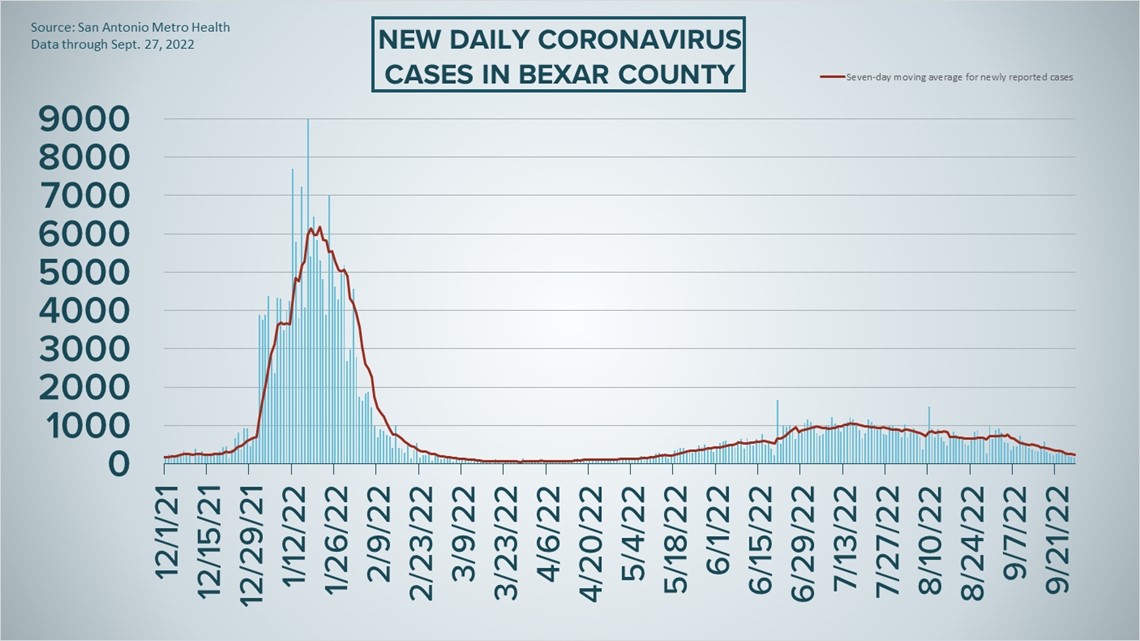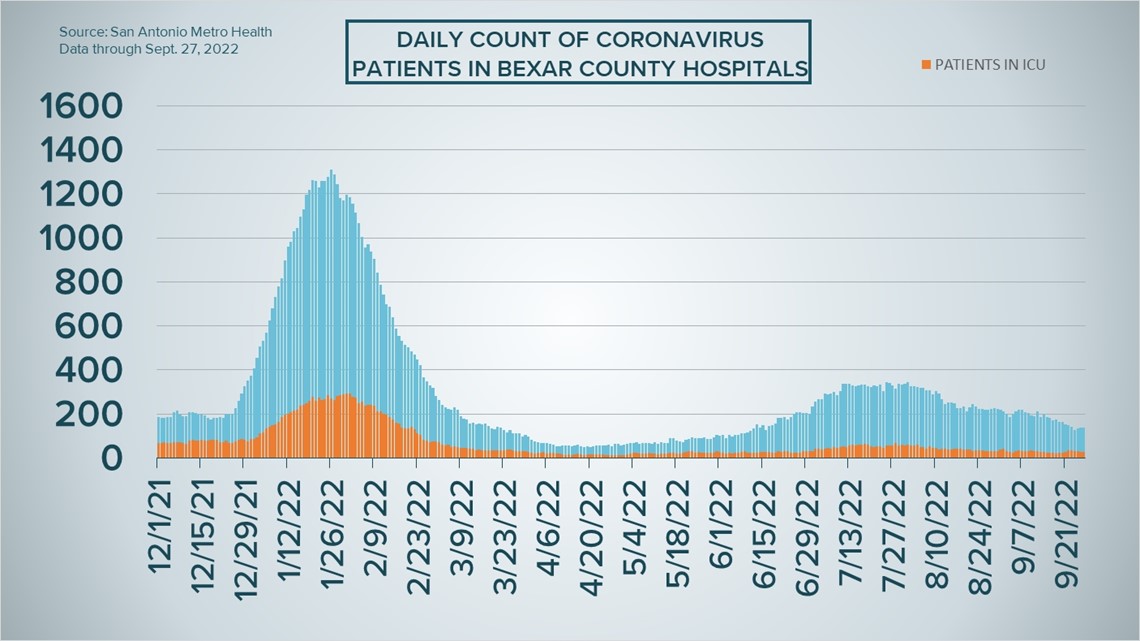SAN ANTONIO — Health officials on Tuesday reported 160 new COVID-19 infections – the lowest single-day count for Bexar County since mid-May – as the San Antonio area continues trending in a positive direction in the latter stages of the pandemic.
The tally brings the seven-day case average down to 242, the lowest that number has been since May 18. Nearly 642,000 coronavirus cases have been reported in Bexar County since the pandemic began (a figure which, it should be noted, doesn't take into account at-home tests when those results aren't reported).
The risk level indicator remains at the medium threshold and "improving."
Hospitalizations are also dropping once again after plateauing for most of August; on Tuesday there were 139 COVID-19 patients receiving treatment at local hospitals. While that's three more than what was reported Monday, local hospitalizations are still down by 15% over the last week and by 34% since Sept. 1.
Of the 139 patients, 28 were in intensive care and just three were using ventilators to help them breathe.
Metro Health continues to hold pop-up vaccine clinics on select days. The next is scheduled for Thursday, on the east side. No appointment is needed, and the immunizations are free.
Just three virus-related deaths have been reported locally over the last two weeks.
How Bexar County is trending




Vaccine progress in Bexar County
The following numbers are provided by San Antonio Metro Health. A full breakdown can be found here.
- 1,469,228 eligible Bexar County residents are fully vaccinated as of Sept. 20, which is about 77.5% of the total population over the age of 4.
- 571,536 eligible Bexar County residents have received a COVID-19 booster shot as of Sept. 20, which is 40.4% percent of the population.
The CDC states that "when a high percentage of the community is immune to a disease (through vaccination and/or prior illness)," that community will have reached herd immunity, "making the spread of this disease from person to person unlikely."
The City of San Antonio breaks down the vaccination rates by zip code on Metro Health's Vaccination Statistics page.
Coronavirus in Texas
The total number of coronavirus cases in the state grew by 1,830 on Tuesday, according to the Texas Department of State Health Services. That total includes 1,179 new confirmed cases and 651 new probable cases. More details can be found on this page.
Tuesday's figures bring the total number of Texans diagnosed with COVID-19 to more than 7.86 million.
Meanwhile, two more Texans have died from virus complications, the state reported Monday, raising the statewide death toll to 89,123.
Coronavirus symptoms
The symptoms of coronavirus can be similar to the flu or a bad cold. Symptoms include fever or chills, cough, shortness of breath or difficulty breathing, fatigue, muscle or body aches, headache, new loss of taste or smell sore throat, congestion or runny nose, nausea or vomiting, and diarrhea, according to the Centers for Disease Control.
Most healthy people will have mild symptoms. A study of more than 72,000 patients by the Centers for Disease Control in China showed 80 percent of the cases there were mild.
But infections can cause pneumonia, severe acute respiratory syndrome, kidney failure, and even death, according to the World Health Organization. Older people with underlying health conditions are most at risk.
Experts determined there was consistent evidence these conditions increase a person's risk, regardless of age:
- Chronic kidney disease
- COPD (chronic obstructive pulmonary disease)
- Obesity (BMI of 30 or higher)
- Immunocompromised state (weakened immune system) from solid organ transplant
- Serious heart conditions, such as heart failure, coronary artery disease, or cardiomyopathies
- Sickle cell disease
- Type 2 diabetes
- The CDC believes symptoms may appear anywhere from two to 14 days after being exposed.
Human coronaviruses are usually spread...
- Between people who are in close contact with one another (within about 6 feet).
- Through respiratory droplets produced when an infected person coughs, sneezes or talks. These droplets can land in the mouths or noses of people who are nearby or possibly be inhaled into the lungs.
- Some recent studies have suggested that COVID-19 may be spread by people who are not showing symptoms.
Help stop the spread of coronavirus
- Stay home when you are sick.
- Eat and sleep separately from your family members
- Use different utensils and dishes
- Cover your cough or sneeze with your arm, not your hand.
- If you use a tissue, throw it in the trash.
Find a testing location
City officials recommend getting a COVID-19 test if you experience fever or chills, cough, shortness of breath or difficulty breathing, fatigue, muscle or body aches, headache, new loss of taste or smell, sore throat, congestion or runny nose, nausea or vomiting, or diarrhea.
Here's a Testing Sites Locator to help you find the testing location closest to you in San Antonio.
Latest Coronavirus Headlines
- Hong Kong to end mandatory hotel quarantine for travelers
- Pfizer seeks to expand omicron booster to 5- to 11-year-olds
- 4.4M Americans roll up sleeves for omicron-targeted boosters
- Canada to drop vaccine mandate at border Sept. 30
- Biden in 60 Minutes interview: COVID-19 pandemic is 'over'
- Poll: Americans give health care system failing mark
- $20 million secured to help San Antonio small businesses recover from pandemic

